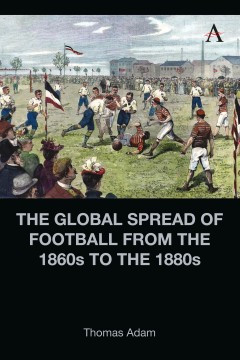The Global Spread of Football from the 1860s to the 1880s
By Thomas Adam
Other Formats Available:
E-Book- About This Book
- Reviews
- Author Information
- Series
- Table of Contents
- Links
- Podcasts
About This Book
So far, the history of football has been written by sport historians who have considered the history of this sport in isolation from the context in which it emerged. In the second half of the nineteenth century, football was created by educators and students as part of school reform. Football served as a new and enticing teaching tool that gave students freedom, encouraged self-determination, and fostered teamwork. After the game had been developed at English public schools, it was introduced by teachers and students at high schools and colleges in England, Germany, Argentina, and the United States during the 1870s. The game proved particularly popular among the children of parents who engaged in trade and industry since this new sport offered an introduction to essential modern values such as teamwork and collaboration that were needed in an industrialized society.
Football was, furthermore, part of the social reform movement that emerged in the second half of the nineteenth century in response to the social ills of urban life. Adults and children spent more and more time inside badly ventilated buildings. Even physical education was conducted inside high school gymnasiums. Beginning in the 1870s, social reformers and teachers called for the introduction into school curricula of physical exercises that could be conducted on the meadows and sport fields outside cities. Those educators joined the calls for the introduction of football into high school curricula found themselves in the company of social reformers who championed the creation of public parks, tenement gardens, and clothing reform.
These two contexts have not mattered in books about the history of football written by sport historians. Sport historians have always separated football from the social and cultural contexts in which it emerged and have paid little attention to the reasons for which football was introduced into German, Argentinian, or American society in the first place. Historians of education have likewise ignored the role of football within school reform. The result is a narrative that provides vertical (national, regional, or local) accounts of this sport from its introduction into a specific geographic space (i.e., city, region, or country) from its first occurrence to the present time. Thisbook, by contrast, will offer a horizontal perspective that focusses on the spread of football in the 1870s from its English cradle to Germany, the United States, and Argentina. It will be the very first account of football that does not treat this sport in isolation but brings together the phenomenon of football with the conditions in nineteenth-century high schools and the crisis of urban living and, thereby, explains why this sport was so willingly and quickly accepted into various societies and cultures around the globe.
Reviews
Author Information
Thomas Adam is Professor of Political Science at the University of Arkansas.
Series
Anthem Intercultural Transfer Studies
Table of Contents
Links
Stay Updated
Information
Latest Tweets



